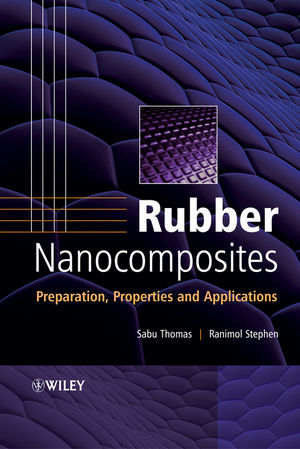Rubber Nanocomposites: Preparation, Properties, and ApplicationsISBN: 978-0-470-82345-3
Hardcover
896 pages
August 2009
 |
||||||
Preface.
Editor Biographies.
1 Nanocomposites: State of the Art, New Challenges and Opportunities (Ranimol Stephen and Sabu Thomas).
1.1 Introduction.
1.2 Various Nanofillers.
1.3 Rubber Nanocomposites.
1.4 Future Outlook, Challenges and Opportunities.
References.
2 Manufacturing Techniques of Rubber Nanocomposites (Jun Ma, Li-Qun Zhang and Li Geng).
2.1 Introduction.
2.2 Melt Compounding.
2.3 Solution Blending.
2.4 Latex Compounding.
2.5 Summary.
Acknowledgments.
References.
3 Reinforcement of Silicone Rubbers by Sol-Gel In Situ Generated
Filler Particles (Liliane Bokobza and Amadou Lamine Diop).
3.1 Introduction.
3.2 Synthetic Aspects.
3.3 Properties of the Hybrid Materials.
3.4 Conclusions.
References.
4 Interface Modification and Characterization (Jun Ma, Li-Qun Zhang and Jiabin Dai).
4.1 Introduction.
4.2 Rubber Nanocomposites Without Interface Modification.
4.3 Interface Modification by Nonreactive Routes.
4.4 Interface Modification by Reactive Routes.
4.5 Characterization of Interface Modification.
4.6 Conclusion.
List of Abbreviations.
Acknowledgments.
References.
5 Natural Rubber Green Nanocomposites (Alain Dufresne)
5.1 Introduction.
5.2 Preparation of Polysaccharide Nanocrystals.
5.3 Processing of Polysaccharide Nanocrystal-Reinforced Rubber Nanocomposites.
5.4 Morphological Investigation.
5.5 Swelling Behavior.
5.6 Dynamic Mechanical Analysis.
5.7 Tensile Tests.
5.8 Successive Tensile Tests.
5.9 Barrier Properties.
5.10 Conclusions.
References.
6 Carbon Nanotube Reinforced Rubber Composites (R. Verdejo, M.A. Lopez-Manchado, L. Valentini and J.M. Kenny).
6.1 Introduction.
6.2 Functionalized Carbon Nanotubes.
6.3 Elastomeric Nanocomposites.
6.4 Outlook.
References.
7 Rubber/Clay Nanocomposites: Preparation, Properties and Applications (K.G. Gatos and J. Karger-Kocsis).
7.1 Introduction.
7.2 Clays and Their Organophilic Modification.
7.3 Preparation of Rubber/Clay Nanocomposites.
7.4 Properties of Rubber/Clay Nanocomposites.
7.5 Applications.
7.6 Outlook.
Acknowledgments.
References.
8 Cellulosic Fibril–Rubber Nanocomposites (Maya Jacob John and Sabu Thomas).
8.1 Introduction.
8.2 Cellulose.
8.3 Cellulosic Nanoreinforcements.
8.4 Studies on Cellulosic/Latex Nanocomposites.
8.5 Conclusions.
References.
9 Nanofillers In Rubber–Rubber Blends (Rosamma Alex).
9.1 Introduction.
9.2 Types of Nanofillers.
9.3 Role of Nanofillers in Reinforcement.
9.4 Methods to Enhance Polymer–Filler Interaction and Reinforcement.
9.5 Role of Nanofiller as Compatibilizer.
9.6 Structure Compatibility Concept of NR-Based Latex Blends.
9.7 Solubility Parameter and Mixing of Latices.
9.8 Preparation of Nanocomposites.
9.9 Rubber Blend Nanocomposites Based on Skim NR Latex and Fresh
NR Latex: Preparation, Characterization and Mechanical Properties.
9.10 Advantages of Nanocomposites and Application of Rubber
Nanocomposites.
References.
10 Thermoplastic Polyurethane Nanocomposites (S.K. Smart, G.A. Edwards and D.J. Martin).
10.1 Introduction.
10.2 Market.
10.3 TPU Chemistry, Morphology and Properties.
10.4 TPU Nanocomposites.
10.5 Layered Silicate/TPU Nanocomposites.
10.6 Carbon Nanotube/TPU Nanocomposites.
10.7 Future Perspectives.
References.
11 Microscope Evaluation of the Morphology of Rubber Nanocomposites (Hiroaki Miyagawa).
11.1 Introduction.
11.2 Optical Microscopy.
11.3 Scanning Electron Microscopy.
11.4 Transmission Electron Microscopy.
11.5 Scanning Probe Microscopy.
11.6 Summary.
References.
12 Mechanical Properties of Rubber Nanocomposites: How, Why . . . and Then? (L. Chazeau, C. Gauthier and J.M. Chenal).
12.1 Introduction.
12.2 Typical Mechanical Behavior of Rubber Nanocomposites.
12.3 How to Explain Reinforcement in Rubber Nanocomposite?
12.4 Modeling Attempts.
12.5 General Conclusions.
References.
13 Nonlinear Viscoelastic Behavior of Rubbery Bionanocomposites (Alireza S. Sarvestani and Esmaiel Jabbari).
13.1 Introduction.
13.2 Rubbery Bionanocomposites.
13.3 Nonlinear Viscoelasticity of Hydrogel Nanocomposites.
13.4 Conclusions.
Acknowledgments.
References.
14 Rheological Behavior of Rubber Nanocomposites (Philippe Cassagnau and Claire Barres).
14.1 Introduction.
14.2 Linear Viscoelasticity.
14.3 Payne Effect.
14.4 Flow Properties of Rubber Nanocomposites.
14.5 Conclusions.
References.
15 Electron Spin Resonance in Studying Nanocomposite Rubber Materials (S. Valic).
15.1 An Approach to the Study of Polymer Systems.
15.2 ESR – Spin Probe Study of Nanocomposite Rubber Materials.
15.3 Summary.
References.
16 Studies on Solid-State NMR and Surface Energetics of Silicas
for Improving Filler–Elastomer Interactions in Nanocomposites (Soo-Jin Park and Byung-Joo Kim).
16.1 Introduction.
16.2 Surface Modification of Silicas.
16.3 Solid-State NMR Analyses of Silicas.
16.4 Surface Energetics of Silicas.
16.5 Other Surface Analyses of Modified Silicas.
16.6 Mechanical Interfacial Properties of the Compounds.
16.7 Conclusions.
References.
17 Wide-Angle X-ray Diffraction and Small-Angle X-ray Scattering Studies of Rubber Nanocomposites (Valerio Causin).
17.1 Introduction.
17.2 WAXD: An Overview.
17.3 SAXS: An Overview.
17.4 Lamellar Fillers.
17.5 Nonlamellar Fillers.
17.6 Characterization of the Matrix in Polymer-Based Nanocomposites.
References.
18 Barrier Properties of Rubber Nanocomposites (Changwoon Nah and M. Abdul Kader).
18.1 Introduction.
18.2 Theoretical Consideration.
18.3 Experimental Studies.
18.4 Applications.
18.5 Conclusions.
Acknowledgments.
References.
19 Rubber/Graphite Nanocomposites (Guohua Chen and Weifeng Zhao).
19.1 Introduction and Background.
19.2 Graphite and its Nanostructure.
19.3 Rubber/Graphite Nanocomposites.
19.4 Future Outlook.
Acknowledgments.
References.
20 Aging and Degradation Behavior of Rubber Nanocomposites (Suneel Kumar Srivastava and Himadri Acharya).
20.1 Introduction.
20.2 Types of Fillers Used in Rubber Nanocomposites.
20.3 Aging of Rubber Nanocomposites.
20.4 Degradation of Rubber Nanocomposites.
20.5 Summary.
References.
21 Positron Annihilation Lifetime Spectroscopy (PALS) and Nanoindentation (NI) (Dariusz M. Bielinski and Ludomir Slusarski).
21.1 Introduction.
21.2 Positron Annihilation Lifetime Spectroscopy.
21.3 Nanoindentation 621
22 Thermoelasticity and Stress Relaxation Behavior of Synthetic Rubber/
Organoclay Nanocomposites (K.M. Sukhyy, E.G. Privalko, V.P. Privalko and M.V. Burmistr).
22.1 Introduction.
22.2 Experimental.
22.3 Polychloroprene/Organoclay Nanocomposites.
22.4 Styrene-co-Butadiene Rubber/Organoclay Nanocomposites.
23 Theoretical Modeling and Simulation of Rubber Nanocomposites (Jan Kalfus and Josef Jancar).
23.1 Introduction.
23.2 Brief Theory of Conformation Statistics and Chain Dynamics.
23.3 Basic Aspects of Rubber Elasticity.
23.4 Mechanisms of Nanocomposite Reinforcement.
23.5 Chains at Rubber–Filler Interfaces.
23.6 Structural Peculiarities of Rubbery Nanocomposites.
23.7 Concluding Remarks.
Acknowledgments.
References.
24 Application of Rubber Nanocomposites (Miroslawa El Fray and Lloyd A. Goettler).
24.1 Introduction.
24.2 Rubber Nanocomposites in Tire Engineering Applications.
24.3 Rubber Nanocomposite Membranes.
24.4 Applications of Rubber Nanocomposites in Sporting Goods.
24.5 Advanced Nanocomposites for Airspace Applications.
24.6 Nanorubbers in Medicine and Healthcare.
24.7 Conclusions.
References.
Index.



